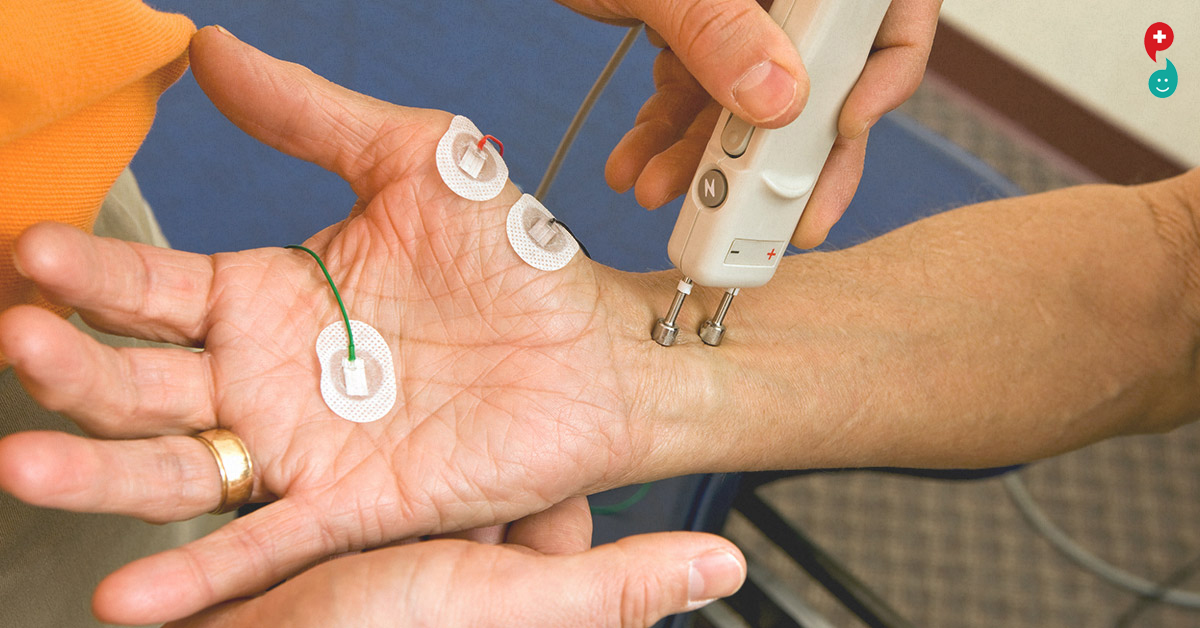About spinal diagnostics: nerve conduction studies
A nerve conduction study is usually done along with electromyography (EMG). The nerve conduction study stimulates specific nerves and records their ability to send the impulse to the muscle. The study can show where there is a blockage of the nerve pathway.
Nerve conduction studies are done to:
Find and evaluate damage to all the nerves that lead away from the brain and spinal cord to the smaller nerves that branch out from them
Help diagnose nerve disorders, such as carpal tunnel syndrome or Guillain-Barré syndrome
Find the location of abnormal sensations, such as numbness, tingling or pain
In a nerve conduction study, several flat metal disc electrodes are taped or pasted to your skin. A shock-emitting electrode is placed directly over the nerve to be studied. A recording electrode is placed over the muscles supplied by that nerve. Several, brief electrical pulses are sent to the nerve. You will feel a brief, burning pain, a tingling sensation and a twitching of the muscle when the electrical pulse is applied. It feels like the tingling you feel when you rub your feet on the carpet then touch a metal object. The testing can be quite uncomfortable and makes some people nervous. Keep in mind that only a very low-voltage electrical current is used. Each pulse is very brief (less than a millisecond).
The time it takes the muscle to contract in response to the electrical pulse is recorded. The speed of the response is called the conduction velocity. The corresponding nerves on the other side of the body may be studied for comparison.
Nerve conduction studies are usually done before an EMG if both tests are being done. Nerve conduction testing takes 15 minutes to an hour or more, depending upon how many areas are studied.
Nerve conduction studies show whether the nerves transmit electrical impulses to the muscles or up the sensory nerves at normal speeds (conduction velocities). Sensory nerves allow the brain to respond to pain, touch, temperature and vibration. Different nerves have different normal conduction velocities. Nerve conduction velocities also tend to decrease as a person gets older. Slower conduction velocities may also be caused by injury or damage to a nerve (such as carpal tunnel syndrome) or group of nerves (such as Guillain-Barré syndrome or post-polio syndrome).
स्पाइनल डायग्नोस्टिक्स बद्दल: तंत्रिका चालना अभ्यास
सामान्यत: इलेक्ट्रोमोग्राफी (ईएमजी) बरोबर नर्व चालविणे अभ्यास केला जातो. तंत्रिका संक्रमणाचा अभ्यास विशिष्ट विशिष्ट तंत्रिकांना उत्तेजित करतो आणि स्नायूंना आवेग पाठविण्याची त्यांची क्षमता रेकॉर्ड करते. तंत्रिका मार्गाचा अडथळा कोठे आहे हे अभ्यास दर्शविते.
नर्व चालविणे अभ्यास हे केले जातात:
मेंदू आणि रीढ़ की हड्डीपासून दूर होणार्या सर्व तंत्रिकांना झालेल्या नुकसानास शोधा आणि त्यांचे मूल्यमापन करा.
कार्पल टनल सिंड्रोम किंवा गिल्लिन-बॅरे सिंड्रोम सारख्या तंत्रिका विकारांचे निदान करण्यात मदत करा
अस्वस्थ संवेदनांचा स्थान शोधा, उदा. निद्रानाश, झुडूप किंवा वेदना
नर्व चालविण्याच्या अभ्यासात, आपल्या त्वचेवर अनेक फ्लॅट मेटल डिस्क इलेक्ट्रोड टेप किंवा पेस्ट केल्या जातात. धक्कादायक उत्सर्जित इलेक्ट्रोड थेट नर्व्हवर अभ्यास केला जातो. त्या तंत्रज्ञानाद्वारे पुरवलेल्या स्नायूंवर रेकॉर्डिंग इलेक्ट्रोड ठेवला जातो. बर्याच वेळा, विद्युतीय दाल तंत्रिकाला पाठवले जातात. इलेक्ट्रिकल पल्स लागू झाल्यावर आपल्याला थोडक्यात, जळणारे वेदना, कंटाळवाणे उत्तेजना आणि स्नायूंचा चिकटपणा वाटेल. जेव्हा आपण कातडीवर आपले पाय घालत असता तेव्हा तुम्हाला जाणवते की धातूच्या वस्तू स्पर्श करा. चाचणी खूपच अस्वस्थ होऊ शकते आणि काही लोकांना चिंताग्रस्त बनवते. लक्षात ठेवा की केवळ कमी-व्होल्टेज विद्युतीय प्रवाह वापरला जातो. प्रत्येक पल्स फार संक्षिप्त आहे (मिलीसेकंदपेक्षा कमी).
इलेक्ट्रिकल पल्सच्या प्रतिक्रियेमध्ये स्नायू लेखी होण्याची वेळ आली आहे. प्रतिसादाच्या गतीला चालना वेग म्हणतात. शरीराच्या दुसऱ्या बाजूस संबंधित संवेदनांचा तुलना करता अभ्यास केला जाऊ शकतो.
दोन्ही चाचण्या केल्या गेल्यास नर्व चालन अभ्यास सामान्यतः ईएमजीच्या आधी केले जातात. तंत्रज्ञानाचा अभ्यास किती अभ्यास केला जातो यावर अवलंबून, 15 मिनिट ते एक तास किंवा अधिक घेते.
तंत्रिका संक्रमणाचा अभ्यास दर्शवितो की नसा स्नायूंना विद्युत प्रवेग किंवा सामान्य वेगाने (संवेग वेग) वर संवेदनाशक तंत्राचा प्रसार करतात की नाही हे दर्शविते. संवेदनाशक तंत्रिका मेंदूला वेदना, स्पर्श, तपमान आणि कंपनेला प्रतिसाद देतात. वेगवेगळ्या तंत्रिकांमध्ये सामान्य चालन वेग आहेत. एखाद्या व्यक्तीचे वय वाढते म्हणून तंत्रिका वाहनांच्या वेग कमी होतात. हळुवार वाहनांच्या वेगाने देखील तंत्रिकाला (जसे की कार्पल टनेल सिंड्रोम) दुखापत किंवा नुकसान होऊ शकते (जसे गुइलिन-बॅरे सिंड्रोम किंवा पोस्ट-पोलिओ सिंड्रोम).










